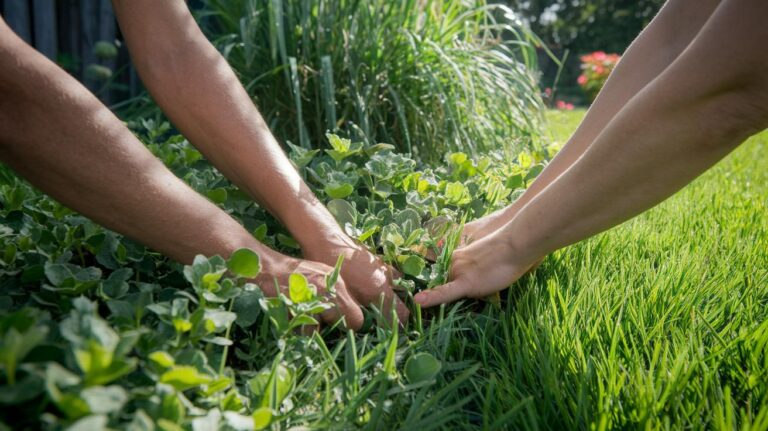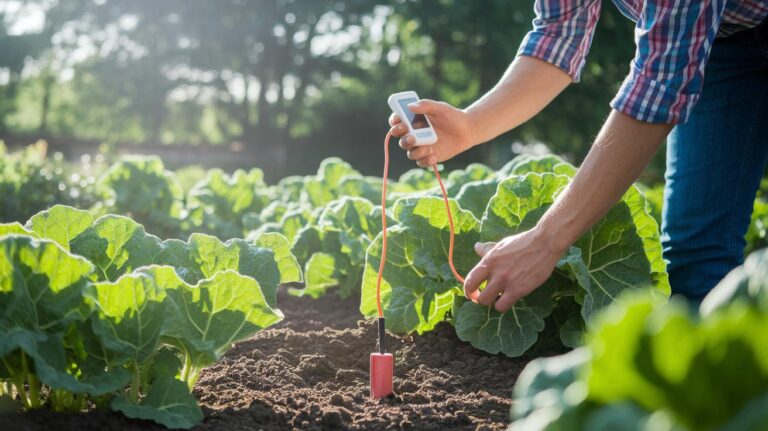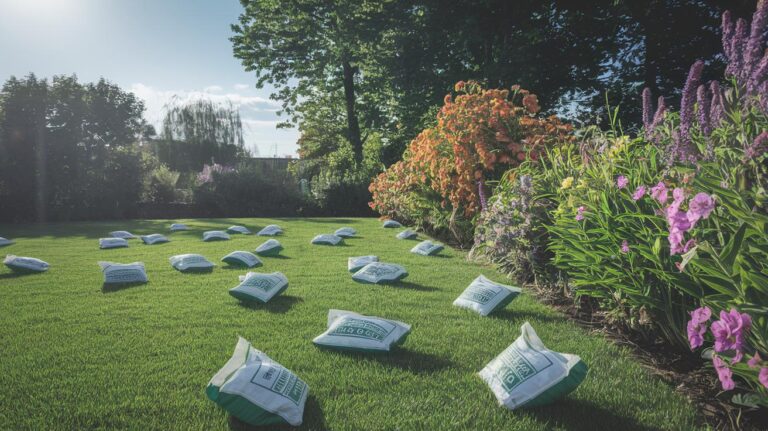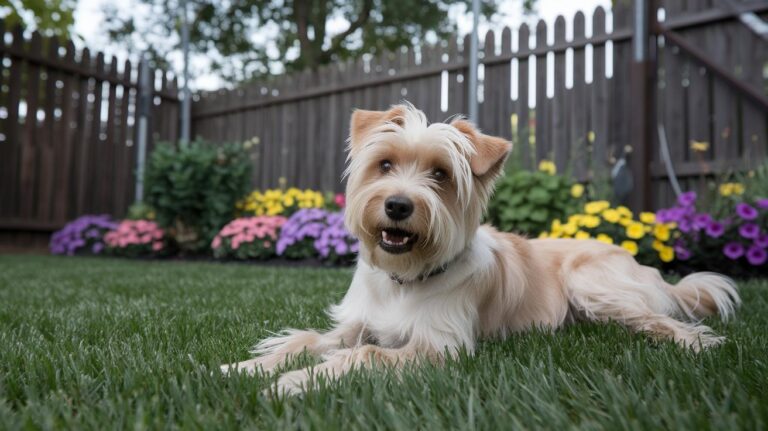How Often Lawn Aeration Ensures Thriving Turf Health
Have you ever stepped on your lawn and felt it give way like a soaked sponge? That squishy mud is begging for tiny air pockets.
By the way, aerating your lawn (making small holes in the ground) will fix that. It loosens compacted soil (soil packed too tight), helps roots slurp up water, and chases away those pesky brown spots.
Picture this: the aerator’s tines slipping into the earth, leaving neat rows of holes and a breath of fresh air underground. Your grass will thank you.
Soon you’ll know exactly when to roll out that aerator so your turf stays soft, green, and strong all season.
Recommended Aeration Schedule For Your Lawn
Have you ever pressed your foot into the lawn and felt it stay flat? That means your soil is compacted (packed-down dirt that’s hard to grow in). Most lawns perk up when you aerate (poke small holes) them once a year. It loosens the earth, lets air slip down, and gives roots room to stretch.
You’ll notice those grass blades look lush and green. Brown dry patches fade away. Curious why this works? Check the benefits of lawn aeration to see how it boosts your turf.
Heavy clay soils pack down like wet mud and can smother roots. Clay lawns might need aeration in spring and fall each year. But sandy or loamy soils feel soft and let water and air seep through, so you can wait two or three years before poking holes again.
Then there’s traffic – kids racing out there, pets digging up the grass… Oops, my cat tried sunbathing on a fresh patch yesterday! All that stomping compresses the soil. I usually give busy lawns another aeration in either spring or fall.
Your grass type and climate also matter. Cool-season grasses like tall fescue and rye bounce back in fall when temperatures drop. So an autumn aeration hits their sweet spot. Warm-season stars such as Bermudagrass shine with a late-spring aeration just as they kick into high gear.
Bottom line: aim for one aeration per year for most yards. If you treat your turf gently, you might stretch it out longer. But lawns that get lots of foot or paw traffic do best with yearly or even biannual aeration. That way your patch stays soft, healthy, and green.
Soil Type, Compaction, and Aeration Frequency

Soil compaction (when soil grains get squeezed so tight) blocks air, water, and nutrients from slipping through. You might hear your shovel thud on rock-hard dirt or see puddles stick around after rain. And those once-lush grass patches start looking thin. That’s your garden pleading for a little TLC.
Try this quick check by poking a screwdriver into damp soil. It should slide in like a knife through warm butter on a muffin. Have you ever felt it snag? That’s compacted soil holding on tight.
When you need to aerate (make tiny holes so roots can breathe), pull out soil plugs (little cylinders of earth) about 2–3 inches long and half an inch wide. Space each plug 2–3 inches apart. Think of each hole as a skinny straw feeding thirsty roots water and air.
Just a heads-up. Do it when the soil’s moist, not soggy. Otherwise you’ll end up with a muddy mess instead of clean plugs. Easy, right?
Aeration Timing For Cool-Season And Warm-Season Grasses
Have you ever felt the warm earth crumble between your fingers? That’s aeration (making little holes in soil so air, water, and nutrients can reach grass roots). Doing this at the right time gives your lawn a real boost.
For cool-season grasses (types of grass that grow best in cooler weather) like tall fescue and perennial rye, plan your aeration for early spring or early fall, around late August to early September works great. That window helps roots dig deep without battling scorching summer heat or winter chill.
Try the finger test: press your finger into the soil. If it feels firm but not rock-hard, you’re ready to aerate. But skip aeration in July’s blazing heat, grass struggles to recover when air and water are scarce.
Now let’s talk warm-season turf (grass that thrives in hot weather). Bermudagrass, Zoysiagrass, and Bahiagrass all need a core aeration (using a machine to pull out small soil plugs) from late spring into early summer.
In southern lawns, I like to overseed (spread extra seed) Bermudagrass with perennial rye after a fall aeration. That keeps your yard looking green when temperatures dip. Zoysiagrass really perks up with a mid-summer poke, and Bahiagrass does best when you aerate in spring-summer.
In drier regions, pick a day right after morning dew or a light rain so the soil’s moist but not soggy. And don’t aerate when the ground’s cold and wet, that just tears grass blades and slows down recovery.
Identifying When Your Lawn Needs Aeration

Does your lawn feel as hard as stepping on pavement underfoot? When you press a screwdriver into the soil, does it barely budge? That’s your soil crying out.
And if you tug at a small patch with a shovel and it feels like wrestling a rock, you’ve got compacted soil (soil packed too tightly for roots to spread). Oops, I once flung dirt everywhere when I tried that.
Look at the thatch (a spongy layer of old grass and roots). If it’s over half an inch thick, water and nutrients can’t sneak through to your grass’s roots.
Notice puddles forming after a rain shower or sprinkler session? That means water isn’t soaking in, and hidden dry spots could be creeping up.
And don’t forget paths where kids and pets roam, bare or thinning strips there are your lawn’s way of begging for a little breathing room. Aeration to the rescue!
Core Aeration Versus Spike Aeration Methods
Core aeration (pulling out little cylinders of soil) is like giving your lawn a breath of fresh air. Those tiny plugs break up hard-packed earth (soil squished too tight) and let air, water, and nutrients sneak down to the root zone. Ever felt the warm earth crumble between your fingers?
Spike aeration (pushing a solid tine into the ground) can pack the soil tighter. It’s like poking holes in a balloon and watching it crease. Over time, this makes the ground even harder for roots.
Got a small yard and don’t mind a workout? A manual core aerator can be your best friend. You’ll step or crank holes by hand, and yep, your legs will talk to you the next day.
For bigger lawns or spots that feel like concrete, try a gas-powered push-behind core aerator. It pulls 2- to 3-inch plugs quickly without wearing you out. You can rent one at the garden center or tool shop.
Even more ground to cover? A tow-behind aerator hooks onto your mower or tractor so you can breeze across acres. By the way, my cat loved sunning herself on the fresh soil.
There’s also slot aeration (no-till aeration) that just slices small channels without pulling plugs. It’s easier on your gear but won’t boost soil porosity (how well soil lets air and water through) as much as full-plug core aeration.
DIY Aeration Versus Professional Lawn Aeration Services

If you want to tackle aeration yourself, renting a core aerator (machine that pulls small plugs of soil) costs about $30 to $50 a day. You can grab aerator shoes for under $20, but those spiked shoes barely punch through packed dirt. Manual aeration tools (hand-held tools for poking holes) are even cheaper, yet you’ll be huffing and puffing over every square foot, best for tiny patches or raised beds. For easiest digging, pick a morning after a light rain. The ground will feel damp underfoot, plugs will pull out cleanly, and your back will thank you.
But if you’d rather skip the sweat, pros charge around $100 to $200 per visit. They roll in with big commercial aerators that yank two- to three-inch plugs, half an inch wide. First, they check soil moisture so your yard isn’t too dry or soggy. Then they walk you through watering tips so fresh seedlings don’t bake under a hot sun. You even get a personalized aeration schedule, no more guessing when to make holes again. Plus, they’ll show you overseeding (spreading grass seeds over your lawn) and after-care tricks to keep turf thick and green without the DIY effort.
Post-Aeration Care For Long-Lasting Benefits
Right after you pull out those little soil plugs, it’s perfect time to overseed and add a gentle topdressing. Dropping fresh seed into each hole gives grass a head start. Then a thin layer of compost-rich soil (decayed organic matter that enriches soil) helps keep seeds from drying out. A quick clean with a rake removes loose bits so each seed snuggles into the earth. Oops, spilled a bit of compost mix there, no big deal.
- Overseed right away. Drop seed into every hole to fill gaps and boost turf density.
- Topdress lightly. Spread a thin layer of compost-rich soil (decayed organic matter that enriches soil) to level the surface, keep seeds moist, and guard against hungry birds.
- Water twice a day for 5 to 10 minutes after aeration. Keep the soil damp for about 10 to 14 days until you see tiny green shoots popping up.
- Once little sprouts appear, water once a day for 20 to 25 minutes. This helps roots dig down deeper.
- After you mow the new grass twice (around week 4 to 6), apply a slow-release nitrogen fertilizer (a plant food that feeds grass slowly). This gives your lawn stronger growth.
- Mow when grass reaches about 3 to 3.5 inches tall. Sharp blades will cut cleanly and avoid pulling out tender new shoots.
By the way, my dog loves rolling on the fresh turf. But back to your care plan, after those steps, slip back into your regular watering and mowing. Soon your yard will feel like a soft green carpet that’s ready for backyard games and summer BBQs.
Final Words
In the action, you discovered that core aeration once a year gives a solid boost to turf health.
We dug into how soil type, foot traffic, and grass species shape your aeration plan. You saw the ideal windows for cool- and warm-season lawns.
Then you learned to spot compaction signs, compare core versus spike tools, weigh DIY against pro services, and nail down post-aeration care. Now you’ve got a clear picture of how often lawn aeration fits your yard. Your grass is ready to shine!
FAQ
How often should I aerate my lawn?
You should aerate most lawns once a year for better soil and root health. Heavy clay soils may need it twice yearly (spring and fall), while sandy or loam soils fare well every 2–3 years.
What’s the best time to aerate and overseed my lawn?
The best time to aerate and overseed cool-season grasses is early spring or early fall. Warm-season turf does best in late spring or early summer. Adjust for regional climate to avoid stress.
How do I aerate my lawn and what tools do I need?
You aerate by core aeration, removing 2–3″ plugs with a manual or machine aerator spaced 2–3″ apart. Rent a gas-powered aerator for large areas or use hand tools for small yards.
How often should I dethatch my lawn?
You should dethatch turf when thatch exceeds ½”. Generally, plan dethatching every 2–3 years for most grasses, but check soil and thatch layer annually for best timing.
Can you over-aerate your lawn?
You can over-aerate turf by aerating more than twice a year, which can stress roots and increase weed invasion. Stick to one core aeration annually unless heavy traffic demands a second session.
Is lawn aeration really necessary?
Aeration is necessary to relieve soil compaction, improve water and nutrient flow, and promote deeper roots. It reduces surface runoff and helps grass withstand drought and foot traffic.
Where can I get lawn core aeration services near me, and does TruGreen provide aeration?
You can find local core aeration services through garden centers or online listings. TruGreen offers professional aeration as part of its lawn care packages. Compare quotes and service details for best value.








One Comment